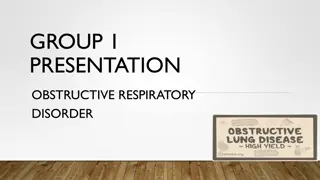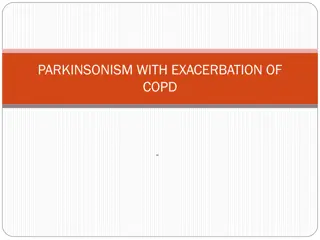Understanding Chronic Obstructive Pulmonary Diseases (COPD) and Emphysema
Chronic Obstructive Pulmonary Diseases (COPD) encompass conditions like chronic bronchitis and emphysema, typically caused by factors like cigarette smoking. This presentation delves into the clinical and functional variances between chronic bronchitis and emphysema in COPD patients, along with an exploration of bronchiectasis. Emphysema, characterized by abnormal enlargement and destruction of respiratory units, is further discussed in terms of its pathophysiology and clinical manifestations. Detailed insights into lung diseases such as centriacinar and distal acinar emphysema are also provided.
Download Presentation

Please find below an Image/Link to download the presentation.
The content on the website is provided AS IS for your information and personal use only. It may not be sold, licensed, or shared on other websites without obtaining consent from the author. Download presentation by click this link. If you encounter any issues during the download, it is possible that the publisher has removed the file from their server.
E N D
Presentation Transcript
Diseases of the Respiratory System Chronic Obstructive Pulmonary Diseases (COPD) Respiratory block 2019 Pathology Lecture 2 Prof. Ammar C. Al-Rikabi Dr. Maha Arafah
Objectives: Give introduction for diffuse lung disease Compare and contrast the major clinical and functional differences between predominant chronic bronchitis versus predominant emphysema in patients with COPD Define Bronchiectasis, its causes, presentation, morphology and significant.
Obstructive lung disease Obstructive Lung Diseases (diffuse) 1) Bronchial Asthma 2) Chronic obstructive pulmonary disease (COPD) Cigarette smoking is the principle cause 10% of population above 45 year has airflow obstruction They are of two types: a) Chronic bronchitis b) Emphysema Common symptoms in lung disease Dyspnea: difficulty with breathing Cough Hemoptysis 3) Bronchiectasis Robbins Basic Pathology Table 13.1 page 498
Diseases of the Respiratory System Emphysema Objectives: a. Define emphysema. b. Describe the gross and microscopic changes in emphysema. c. Discuss the typical clinical presentation and causes of death. d. Describe the most likely mechanism of emphysema (the protease-antiprotease mechanism). e. Describe the pathophysiologic mechanisms of emphysema
Emphysema Emphysema abnormal permanent enlargement of all or part of the respiratory unit accompanied by destruction of their walls Associated with loss of elastic recoil and support of small airways leading to tendency to collapse with obstruction
Diseases of Lung 1. Centriacinar: in heavy smoker, severe in upper lobes 2. Alpha 1 antitrypsin deficiency: Commonly affect both lower lobes at lower zones 3.Distal acinar /paraseptal: adjacent to areas of fibrosis or atelectasis More severe in the upper half of the lungs, young adult, unknown cause, spontaneous peumothorax 4. Irregular Associated with scarring, e.g. in TB Asymptomatic Classification of emphysema
Emphysema: morphology Diseases of Lung Generalized emphysema. (a) Normal distal lung acinus. (b) Centriacinar emphysema. (c) Centriacinar emphysema. (d) Panacinar emphysema. (e) Panacinar emphysema (Gough-Wentworth section).
Diseases of Lung Emphysema
Distal acinar /paraseptal: forming multiple cyst-like structures with spontaneous pneumothorax.
Emphysema Emphysema: Pathogenesis Pathogenesis of Emphysema
Emphysema: morphology Destruction of some alveolar septi Enlarged air spaces/alveolar spaces. Paraseptal emphysema, microscopic destruction of alveolar walls
Emphysema: morphology Enlarged air spaces File:Emphysema low mag.jpg Destruction of some alveolar septi
Pursed lip expiration is a common maneuver adopted by patients with severe chronic obstructive pulmonary disease including emphysema. The patient starts to breathe out closed or nearly closed lips to keep the intrabronchial pressure high and prevent collapse of the bronchial wall and expiratory obstruction. Later in expiration the lips are blown forwards and open, often with a grunt ( fish-mouth breathing). Emphysema:- Clinical features: Dyspnea Patient is sitting forward in a hunched- over position
Barrel-shaped chest in a patient with emphysema. The hyperinflation result from 1. air-trapping with inflammatory changes 2. hypersecretion of viscid contraction in the small airways. Note the associated indrawing of the intercostal muscles. Similar changes are seen in patients with chronic bronchitis and asthma.
Emphysema: Complications Pneumothorax Pulmonary hypertension (due to destruction of small capillaries in alveolar wall and hypoxia lead to pulmonary vascular spasm) Right-sided heart failure (Cor pulmonale) Death from emphysema is related to: Pulmonary failure with respiratory acidosis, hypoxia and coma or due to pulmonary hypertension.
Emphysema: SUMMARY Emphysema: Dilated air spaces beyond respiratory bronchioles due to destruction of alveolar septa Centriacinar: Smoking Panacinar: deficiency of 1 AT Paraseptal: Occurs adjacent to areas of fibrosis or atelectasis. Irregular: scar Types Cough and wheezing. Dyspnea Weight loss Pulmonary function tests reveal low FEV1 Pink puffers. Respiratory acidosis Clinical features Pneumothorax Pulmonary hypertension. Right-sided heart failure (Cor pulmonale) Pulmonary failure with respiratory acidosis, hypoxia and coma. Complications
Diseases of the Respiratory System Chronic Bronchitis Objectives: a. Define chronic bronchitis. b. Describe the causes, pathogenesis and the morphology of chronic bronchitis. c. Describe the mechanism of airway obstruction in a patient with chronic bronchitis. d. Understand that when severe obstruction is present in chronic bronchitis, significant emphysema is nearly always present
Chronic Bronchitis Chronic Bronchitis: defined as persistent productive cough for at least 3 consecutive months in at least 2 consecutive years Causes Cigarette smoking is the most important risk factor Air pollutants Cystic fibrosis
Chronic Bronchitis: morphology Chronic bronchitis
Chronic Bronchitis: morphology Chronic bronchitis
Chronic Bronchitis: morphology Chronic bronchitis. In chronic bronchitis the main abnormality is secretion of abnormal amounts of mucus, causing plugging of the airway lumen (P)
Chronic Bronchitis Clinical features and compilcations Persistent reproductive cough Dyspnea on exertion Hypercapnia, hypoxemia, cyanosis (blue bloaters) Emphysema Cor pulmonale Death due to further impairment of respiratory functions after superimposed acute baterial infections.
Chronic Bronchitis Definition: Persistent productive cough (with sputum) for at least Definition: Persistent productive cough (with sputum) for at least 3 3 months in at least months in at least 2 2 consecutive years consecutive years Cigarette smoking is the most important risk factor; air pollutants also contribute Causes enlargement of mucous-secreting glands, goblet cell hyperplasia, chronic inflammation, and bronchiolar wall inflammation and fibrosis. Features Persistent reproductive cough, dyspnea on exertion, hypercapnia, hypoxemia, cyanosis, cor pulmonale with edema (blue bloater) Death may result from further impairment of respiratory function due to superimposed acute infections. Complications
Bronchiectasis Objectives: Definition Causes Presentation morphology and significant
Bronchiectasis Bronchiectasis is permenant dilatation of bronchi with destruction of their walls. It is a result of chronic inflammation associated with an inability to clear mucoid secretions.
us Causes of bronchiectasis Bronchial obstruction 1. Localized: Generalized: - bronchial asthma - chronic bronchitis - tumor, foreign bodies or mucous impaction Congenital or hereditary conditions 2. - Congenital bronchiectasis - Cystic fibrosis. - Intralobar sequestration of the lung. - Immunodeficiency status. - Immotile cilia and kartagner syndrome Chronic or severe infection / necrotizing pneumonia 3. Caused by TB, staphylococci or mixed infection
Diseases of Lung Cilial dysmotility syndrome. Electron micrograph of cilia from a person with recurrent chest infections since childhood. The outer dynein arms are absent and there are abnormal single microtubules (M), which prevent normal motility.
Presentation of Bronchiectasis Severe, persistent cough associated with expectoration of mucopurulent, sometimes bad smell sputum. Other common symptoms include dyspnea, rhinosinusitis, and hemoptysis. Bronchiectasis, chest radiograph
Diseases of Lung Bronchiectasis Dilatation of bronchi with destruction bronchial walls of
Diseases of Lung Bronchiectasis. This is a lower lobe of lung surgically resected for bronchiectasis.
Lung Abscess Bronchiectasis Complications 1. Obstructive pulmonary function (hypoxemia, hypercapnia, pulmonary hypertension, and cor pulmonale) 2. Lung Abscess Rare complications: include I. Metastatic brain (cerebral) abscess II. Amyloidosis. Brain (cerebral) abscess
Bronchiectasis Dilatation and destruction of bronchi and bronchioles secondary to chronic inflammation and obstruction Bronchiectasis: Infection/ Necrotizing pneumonia Obstruction Congenital (Cystic fibrosis, Kartagener s Syndrome) Causes Sever persistent cough with sputum (mucopurulent sputum) sometime with blood. Clubbing of fingers. Clinical features If sever, obstructive pulmonary function Lung Abscess Rare complications: metastatic brain(cerebral) abscess and amyloidosis. Complications
Diseases of Lung Key Facts Chronic obstructive pulmonary disease . Definition: a disease state characterized by airflow limitations that are not fully reversible. The airflow limitation is usually both progressive and associated with an abnormal inflammatory response of the lungs to noxious particles or gases. . Cigarette smoking remains the most important cause of COPD. Other risks are recurrent chest viral infections in childhood, atopy, asthma, and occupational exposure to dusts (especially mining). . Respiratory bronchiolitis is one of the earliest lesions seen in smokers. . Chronic bronchitic airways show mucous hypersecretion with mucous gland hyperplasia. . Chronic bronchitis and bronchiolitis cause airway narrowing. . Emphysema causes loss of elastic recoil in lungs and contributes to functional airways obstruction. . Generalized emphysema is defined as permanent dilatation of any part of the respiratory acinus, with destruction of tissue in the absence of scarring. . There are two patterns of generalized emphysema: centrilobular and panacinar. . Many patients with COPD have a reversible component to functional airways obstruction. . Pulmonary hypertension and right-sided heart failure are common in long-standing chronic obstructive pulmonary disease. . Acute deterioration in COPD is usually caused by viral or bacterial infection.























